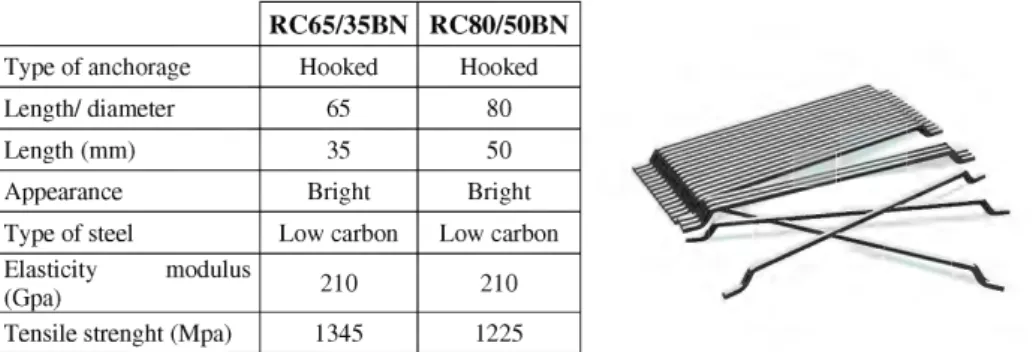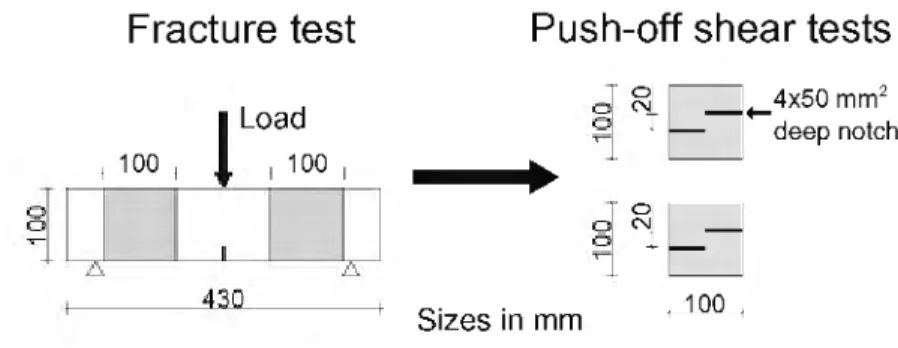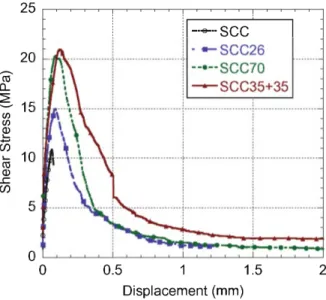Assessment of the Shear Strength of Steel
Fibre-Reinforced Concrete
Álvaro Picazo , Marcos G. Alberti , Alejandro Enfedaque , and Jaime C. Gálvez ( )
Departamento de Tecnología de la Edificación, E.T.S de Edificación, Universidad Politécnica de Madrid, Avda. Juan de Herrera, 6,
28040 Madrid, Spain
a.picazo@upm.es
2
Departamento de Ingeniería Civil: Construcción, E.T.S de Ingenieros de Caminos, Canales y Puertos, Universidad Politécnica de Madrid, C/Profesor Aranguren,
s/n, 28040 Madrid, Spain
jaime.galvez@upm.es
Abstract. Steel fibres when added to concrete, form what has been termed steel fiber-reinforced concrete (SFRC). The merger of these two materials boasts an improved post-cracking strength maintaining a high durability. Such features enable the use of SFRC in structural applications thanks to the appearance in recent times of standards and recommendations that assess its structural capacity based on flexural tests. However, the shear behaviour of a structural material is of key importance and up to now there are few studies dealing with this issue. In order to widen the knowledge in this area this contribution presents the experimental results of push-off shear tests performed in SFRC. The samples employed were double-notched ones and they were subjected to compressive forces in the tip of both notches creating pure shear stresses in the ligament. The influence of the fibre dosage was analysed by manufacturing two self-compacting concretes with 26 and 70 kg/m3 of fibre. Moreover, the influ-ence of the fibre length was studied by using 35 and 50 mm-long fibres. Fur-thermore, the shear behaviour was also connected with the fracture behaviour of the same specimens shown in previous studies of the same authors.
Keywords: Steel fibre-reinforced concrete • Shear strength • Push-off test • Concrete
1 Introduction
cases was firstly seen in 1874 (Berard 1874) when the concept of randomly distributed fibres added to concrete was first developed. The presence of fibres reduces the brittle behaviour of concrete and in addition, they might improve some characteristics of the material. Traditionally, this type of concrete has been termed fibre reinforced concrete (FRC). The purpose of the addition of fibres in concrete can be reducing shrinkage, avoiding cracking during setting, improving the fire resistance and the mechanical properties of concrete among others (Romualdi and Batson 1963; Romualdi 1964). In the last decades, the use of fibres as a way to improve the flexural and tensile behaviour of concrete has been profusely applied in pavements and tunnels, amongst others (Caratelli 2011; López 2014; Serna 2009; Tiberti 2014; Alberti 2015). All these applications have been possible due to the standards and regulations that establish the requirements that the material should meet in order to take into account the contribution of the fibres in the structural design. Those documents, such as the Model Code 2010, EN-14651 or even national codes of structural concrete (EHE-08) (fib 2010; EN 14651
2007; EHE 2008) evaluate the influence of the fibres only considering their contri-bution to the flexural or tensile behaviour. However, it is necessary to study the influence of the fibres in the shear behaviour of a FRC if a complete characterisation of the influence of fibres wants to be achieved.
Up to now, there are certain studies that have determined the shear behaviour of FRC manufactured with steel fibres (Barragán 2002; Cuenca 2012). Other research have dealt with finding the equivalence between the amount of fibres added and the number of stirrups in structural concrete elements (Turmo 2008). The shear behaviour has been also evaluated by means of push-off tests in Z-prism-shaped specimens with two parallel notches (Echegaray 2014). However, in all cases there is still a certain degree of uncertainty in the field that deserves to be analysed.
In order to complement the available information in the matter up to now, an experimental campaign, which seeks to evaluate the shear behaviour of FRC by means of push-off tests, has been developed. The influence of the fibre content has been studied by manufacturing concrete with 26 and 70 kg/m3 of steel fibres which were termed SCC26 and SCC70. Moreover, the influence of the fibre length has been found thanks to the addition of fibres with two different lengths in one of the 70 kg/m3 -fibre-added concrete. In this case the concrete has been named SCC35+35. As a reference a plain concrete named SCC was manufactured. The results showed that the addition of fibres does not only increase the shear strength but also the residual shear strength and the ductility of the fibre reinforced concretes studied. In addition, the longer fibres had no influence in the shear strength but also increased the residual shear strength for relevant crack displacements.
2 Experimental Programme and Concrete Properties
Type of anchorage Length/ diameter
Length (mm)
Appearance
Type of steel
Elasticity modulus (Gpa)
Tensile strenght (Mpa)
RC65/35BN Hooked 65 35 Bright Low carbon 210 1345 RC80/50BN Hooked 80 50 Bright Low carbon 210 1225
Fig. 1. Steel fibres used. Appearance of one of the RC65/35BN fibres used. The other type of fibres shows a similar outlook.
were added which are named RC65/35BN and RC80/50BN (50% and 50%) respec-tively. The main characteristics of such fibres can be seen in table in Fig. 1. In addition the appearance of RC65/35BN can be seen in Fig. 1.
The formulation of the concretes used can be seen in Table 1. It has to be high-lighted that concrete formulations used were capable of consolidate by the action of their own weight. Therefore they were considered as self-compacting concrete (SSC). As can be seen in Table 1 the formulations of the concrete matrixes used are not identical but for the purpose of the present paper this variations might be considered of reduced relevance.
Table 1. Concrete formulations manufactured fibres.
SCC SCC26 SCC70 SCC35 +35 Cement 425 375 425 425 Limestone powder 210 200 210 210 Water 190 187 190 190 Sand 947 918 947 947 Grit -245 -Gravel 510 367 486 486 w/c ratio 0.47 0.50 0.47 0.47 Steel fibers
-26 kg RC65/35BN 70 kg RC65/35BN 35 kg RC65/35BN + 35 kg RC80/50BN
SP (%) 1.39 1.25 1.39 1.39
The mechanical properties of all the formulations used can be seen in Table 2. Such properties were obtained by following these standards (ASTM C469 2002, EN 12390-3
2009, EN 12390-6 2009)15-17]. It has to be highlighted that there were only subtle differences in the values obtained in the modulus of elasticity tests. Moreover, there are no clear trends between the modulus of elasticity of the concretes tested and the amount
Table 2. Mechanical properties of the concretes.
Modulus of elasticity (Gpa) fck, 28 days (MPa) fct, 28 days (MPa)
or type of fibres added. In the case of the characteristic strength, it seems that the higher fibre content the greater strength obtained. In the case of the indirect tensile strength, it can be clearly perceived, as it was expected, that the presence of the fibres has a positive influence in the material properties.
The samples used in the push-off tests were obtained from the halves remaining of fracture tests performed on 100 x 100 x 430 mm3 notched samples. After a visual inspection that assured that no damaged had appeared far from the whereabouts of the notched and the cracked area the sample obtaining process begun. From each of the halves a cubic sample of 100 mm of side was obtained. In order to carry out the push off tests in each sample two notches of 50 mm of length in their opposite sides were cut with a water refrigerated circular saw. Therefore, a ligament plane in the central part of the samples was obtained. This process has been sketched in Fig. 2. The front and rear sides of the samples were reinforced by means of carbon fibre sheets glued using epoxy resin. This reinforcement was used to avoid undesired failure modes by flexural bending that might have been introduced during the tests which broke the lower or upper overhangs.
Fracture test
Load
100
\
I 100
A A
430
Push-off shear tests
4x50 mm2 deep notch
100 Sizes in mm
Fig. 2. Obtaining specimens for testing push-off.
The tests were carried out in a universal testing machine with a maximum capacity of loading of 500 KN. The tests were controlled by setting the movement rate of the machine actuator at a micron per second. In order to introduce pure shear stress in the ligament plane two compressive forces were applied in the middle strip of the lower and upper sample planes. To concentrate the load introduced two squared steel bars of 10 mm2 section were employed as can be seen in the sketch of Fig. 3. The correct vertical alignment of the tip of the notches and steel bars used were checked using a laser level.
Fig. 3. Test setup.
3 Results and Discussion
The average results of tests performed with three specimens of each concrete formu-lation can be seen in Fig. 4. The stiffness of the concrete types is highly constant in all formulations in the first part of the curves. Therefore, the influence of the fibres types and the amount of fibres are negligible while the integrity of the material is conserved. However, when reaching 6 MPa of shear stress the behaviour of the formulations start to differ. In the case of SCC the slope of the curve decreases noticeably until the shear strength is reached at 10.18 MPa where a sudden drop of the load takes place. In the case of the SCC26 formulation the presence of 26 kg/m3 of steel fibres mitigate the reduction of stiffness previously commented. Thus, the material was capable of with-standing higher stresses although it was being damaged. The shear maximum strength in this formulation was 15 MPa. In contrast with behaviour of SCC the decrease of the load that the material can bear after the peak load was reached was remarkably gradual and no sudden load drops were perceived.
25
15
10 I
••e~ S C C
•—SCC26
-•"SCC70 - * S C C 3 5 + 3 5
B-w_ J ^ ^ ' ' * *—*—* * *
• ^ F l ' M - i • . . . — . » - — . ,
0.5 1 1.5
Displacement (mm)
Fig. 4. Mean shear stress displacement curves.
5
The most part of the decrease in the loads took place before 0.5 mm of displacement. After such a displacement only a limited portion of the load was sustained by the material and it was decreasing as the displacement grew. However, at 0.8 mm of displacement a residual load bearing capacity of the material was observed. It seems that the SCC26 formulation was able to withstand above 1.2 MPa. In the case of SCC70, the behaviour of the sample is highly influenced by the presence offibres. Such fibres enabled an improved shear load bearing capacity when compared both with SCC and SCC26 formulations. In addition, in the part of the curve previous to the peak stress it can be clearly perceived that the stiffness of the material is greater than in the case of SCC26. Similarly, the maximum stress exceeds the values registered for SCC and SCC26. After the peak stress the unloading process is analogous to the SCC26 formulation. The load decreases gradually until 0.4 mm of displacement and beyond that point the reduction rate slows down. It has to be highlighted that from 0.4 mm of displacement the behaviour of SCC26 and SCC70 showed hardly any difference among them. Regarding the SCC35+35 formulation it can be perceived that there are scarcely any differences between SCC70 and SCC53+35 before the peak stress is reached. Nevertheless, the two types offibres enable changing the unloading rate of the formulation with respect to the SCC70 one. Moreover it has to be highlighted that the presence of longer fibres changed the unloading behaviour of the material. It is clear that the material can absorb a greater amount of energy if the two types of fibres are combined.
Table 3. Evolution and coefficient of variation (c.v.) of the mean value of shear residual strength (s) of three tests per formulation.
SCC
SCC26 SCC70 SCC35+35
speak
10.18 15.36 21.39 21.15
c.v. 0.10 0.21 0.15 0.16
s0.5 mm
-3.36 3.40 6.02
c.v. -0.55 0.31 0.15
s1.0 mm
-1.20 1.50 2.83
c.v. -0.36 0.27 0.23
s1.5 mm
-1.05 1.91
c.v. -0.28 0.38
In Table 3 the evolution of the residual shear stress (s) of all the formulations tested can be seen. It is clear that the presence of fibres increase the maximum shear strength that the SFRC can bear. The greater amount of fibres the higher shear strength. It can be also highlighted that the increment of the shear strength is not proportional to the amount of fibres. Having less than half of the fibre content SCC26 is only 25% less than the values obtained both in SCC70 and SCC35+35. Regarding the results at a dis-placement greater than the one at the peak stress the influence of the longer fibres is more important. At 0.5 mm, 1 mm and 1.5 m there are no remarkable differences between SCC26 and SCC70. That supposes that the characteristics of the fibres are more relevant that the amount of fibres. This trend can be perceived if the stress values of SCC35+35 are compared with the values of SCC70.
Table 4. Fracture energy of concretes subjected to shear stresses.
SCC
SCC26 SCC70 SCC35+35
Gf (N/m) 680 5518 7790 11609
DGf (%)
711 1045 1607
4 Conclusions
The present contribution sought to complete the current knowledge about the mechanical response of SFRC when subjected to pure shear stress. This aspect is considered by the authors of capital importance due to the fact that the existing reg-ulations and recommendations allow to consider the contribution of the fibres in the structural design based only in the flexural behaviour of the material but does not consider their contribution to the shear stresses. The push-off tests performed suppose a further approach towards defining the contribution of the fibres in the shear behaviour of a concrete element when medium and high amounts of fibres are added to a self-compacting concrete.
The results showed that moderate amounts of fibres increase both the shear strength and ductility of the concrete avoiding a brittle failure of the material. When high amounts of fibres are added, the shear strength is doubled when compared to a plain SCC. It has to be highlighted that in the case of fracture tests the fibres were not able to increase the peak load at small crack openings.
Regarding the ductility of the concretes manufactured with high amounts of steel fibres it has to be underlined that both mixes were able to main certain degree of integrity until a displacement of 1.5 mm was reached. Another point that is worth to mention is that by increasing the fibre length of the half of the fibres added the residual strength of the material is enhanced up almost 1.50 MPa. In addition, this cocktail of fibres had hardly any influence in the peak shear stresses.
The continuation of this research line might enable, if a more detailed knowledge is achieved, to consider not only the flexural but also de shear contribution of the fibres in the structural design.
Acknowledgements. The authors gratefully acknowledge the financial support provided by Ministry of Economy and Competitiveness of Spain by means of the Research Fund Project BIA 2016 78742-C2-2-R.
References
ASTM C469-02e1: Standard test method for static modulus of elasticity and Poisson’s ratio of concrete in compression (2002)
Barragán, P.: Failure and toughness of steel fibre reinforced concrete under tension and shear. Ph.D. thesis, Universidad Politécnica de Valencia, Valencia (2002)
Berard, A.: Improvement in artificial stone. Patent U.S. Patent No. 157,903, 15 December 1874 Caratelli, A., Meda, A., Rinaldi, Z., Romualdi, P.: Structural behaviour of precast tunnel segments in fiber reinforced concrete. Tunn. Undergr. Space Technol. 26(2), 284-291 (2011) Cuenca, E.: On shear behaviour of structural elements made of steel fibre reinforced concrete.
Ph.D. thesis, Universidad Politécnica de Valencia, Valencia (2012)
Echegaray, J.: Upgrading the push-off test to analyse the contribution of steel fibre on shear. Ph.D. thesis, Universidad Politécnica de Valencia, Valencia (2014)
EHE-08: Spanish Structural Concrete Code, Spanish Minister of Public Works (2008) EN 12390-3:2009: Testing hardened concrete. Part 3: compressive strength of test specimens
(2009)
EN 12390-6:2009: Testing hardened concrete. Part 6. Tensile spliting strength of test specimens (2009)
EN 14651:2007+A1: Test Method for Metallic Fibre Concrete. Measuring the Flexural Tensile Strength (Limit of Proportionality (LOP), Residual) (2007)
fib Model Code, Model Code. Fédération Internationale du Béton fib/International Federation for Structural Concrete, Paris (2010)
Lopez, J.A., Serna, P., Camacho, E., Coll, H., Navarro-Gregori, J.: First ultra-high-performance fibre-reinforced concrete footbridge in Spain: design and construction. Struct. Eng. Int. 24(1), 101-104 (2014)
Romualdi, J.P., Batson, G.B.: Behaviour of reinforced concrete beams with closely spaced reinforcement. ACI J. Proc. 60(6) (1963)
Romualdi, J.P.: Tensile strength of concrete affected by uniformly distributed and closely spaced short lengths of wire reinforcement. ACI J. Proc. 657-672 (1964)
Serna, P., Arango, S., Ribeiro, T., Nunez, A.M., Garcia-Taengua, E.: Structural cast-in-place SFRC: technology, control criteria and recent applications in Spain. Mater. Struct. 42(9), 1233-1246 (2009)
Tiberti, G., Minelli, F., Plizzari, G.: Reinforcement optimization of fiber reinforced concrete linings for conventional tunnels. Compos. B 58, 199-207 (2014)


